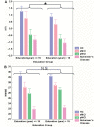Early diagnosis of Alzheimer's disease using cortical thickness: impact of cognitive reserve
- PMID: 19439419
- PMCID: PMC2714060
- DOI: 10.1093/brain/awp105
Early diagnosis of Alzheimer's disease using cortical thickness: impact of cognitive reserve
Abstract
Brain atrophy measured by magnetic resonance structural imaging has been proposed as a surrogate marker for the early diagnosis of Alzheimer's disease. Studies on large samples are still required to determine its practical interest at the individual level, especially with regards to the capacity of anatomical magnetic resonance imaging to disentangle the confounding role of the cognitive reserve in the early diagnosis of Alzheimer's disease. One hundred and thirty healthy controls, 122 subjects with mild cognitive impairment of the amnestic type and 130 Alzheimer's disease patients were included from the ADNI database and followed up for 24 months. After 24 months, 72 amnestic mild cognitive impairment had converted to Alzheimer's disease (referred to as progressive mild cognitive impairment, as opposed to stable mild cognitive impairment). For each subject, cortical thickness was measured on the baseline magnetic resonance imaging volume. The resulting cortical thickness map was parcellated into 22 regions and a normalized thickness index was computed using the subset of regions (right medial temporal, left lateral temporal, right posterior cingulate) that optimally distinguished stable mild cognitive impairment from progressive mild cognitive impairment. We tested the ability of baseline normalized thickness index to predict evolution from amnestic mild cognitive impairment to Alzheimer's disease and compared it to the predictive values of the main cognitive scores at baseline. In addition, we studied the relationship between the normalized thickness index, the education level and the timeline of conversion to Alzheimer's disease. Normalized thickness index at baseline differed significantly among all the four diagnosis groups (P < 0.001) and correctly distinguished Alzheimer's disease patients from healthy controls with an 85% cross-validated accuracy. Normalized thickness index also correctly predicted evolution to Alzheimer's disease for 76% of amnestic mild cognitive impairment subjects after cross-validation, thus showing an advantage over cognitive scores (range 63-72%). Moreover, progressive mild cognitive impairment subjects, who converted later than 1 year after baseline, showed a significantly higher education level than those who converted earlier than 1 year after baseline. Using a normalized thickness index-based criterion may help with early diagnosis of Alzheimer's disease at the individual level, especially for highly educated subjects, up to 24 months before clinical criteria for Alzheimer's disease diagnosis are met.
Figures




References
-
- Alexander GE, Chen K, Pietrini P, Rapoport SI, Reiman EM. Longitudinal PET evaluation of cerebral metabolic decline in dementia: A potential outcome measure in Alzheimer's disease treatment studies. Am J Psychiatry. 2002;159:738–45. - PubMed
-
- Ashburner J, Friston K. Multimodal image coregistration and partitioning–a unified framework. Neuroimage. 1997;6:209–17. - PubMed
-
- Ashburner J, Friston KJ. Voxel-based morphometry–the methods. Neuroimage. 2000;11(6 Pt 1):805–21. - PubMed
-
- Bloch I. Fuzzy spatial relationships for image processing and interpretation: a review. Image Vis Comput. 2004;23:89–110.
-
- Coffey CE, Saxton JA, Ratcliff G, Bryan RN, Lucke JF. Relation of education to brain size in normal aging: implications for the reserve hypothesis. Neurology. 1999;53:189–96. - PubMed
Publication types
MeSH terms
Grants and funding
LinkOut - more resources
Full Text Sources
Medical
Miscellaneous

